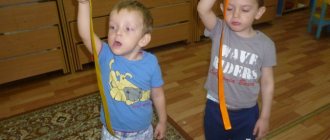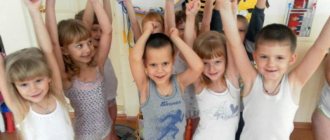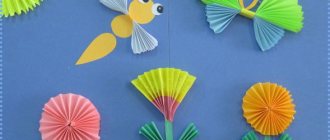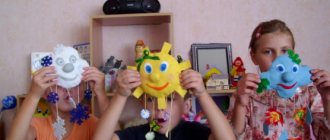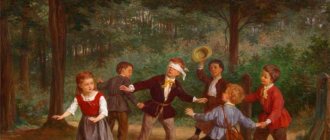Breathing exercises as a means of hardening and improving the health of preschool children
Shafikova I.M. Breathing exercises as a means of hardening and improving the health of preschool children // Sovushka. 2018. N2(12). URL: https://kssovushka.ru/zhurnal/12/ (access date: 01/18/2022).
Order No. 110417
Breath is life!
Breathing is the most important source of life. A person can live without food and water for several days, but without air, at most, a few minutes. Modern medicine believes that developing proper breathing is the key to good health. Therefore, it is important to pay great attention to developing proper breathing. The respiratory system of children is imperfect, and the smaller the child, the narrower all the respiratory tracts are, and the mucous membrane lining them is very delicate, easily inflamed, even under the influence of dust particles; at the same time, the already narrow passages become even narrower, and it becomes difficult for the child to breathe. The smaller the child, the smaller the vital capacity of the lungs, the smaller, and the need for oxygen is high, so the child breathes frequently and shallowly. That is why it is necessary to include breathing exercises in a complex of physical education and health exercises. Breathing exercises strengthen the respiratory muscles, develop chest mobility, promote deep breathing and stability of the breathing rhythm, and increase the vital capacity of the lungs. They contribute to the full physical development of children and prevent diseases of the respiratory system. Breathing exercises in preschool age are aimed at increasing the child’s overall vitality and the resistance, hardening and resistance of his body to diseases of the respiratory system.
Let's look at what are the positive effects of breathing exercises on the human body.
First of all, breathing exercises affect metabolic processes in the child’s body, improve the drainage function of the bronchi, restore impaired nasal breathing, promote the resorption of inflammatory formations, and the straightening of inflammatory formations. Breathing exercises help saturate every cell of the body with oxygen. And a person’s ability to control breathing contributes to the ability to control oneself. In addition, breathing exercises are simply necessary for children who often suffer from colds, bronchitis, as well as those recovering from pneumonia or suffering from bronchial asthma.
In order to systematically use breathing exercises, they must be included in complexes: morning exercises, physical education classes, swimming lessons, outdoor games, physical education, finger exercises, sound breathing exercises.
Techniques for performing breathing exercises for children
- take in air through the nose;
- do not raise your shoulders;
- exhalation should be long and smooth;
- after exhaling, stop for 2-3 seconds
- you need to make sure that your cheeks do not puff out (to begin with, you can hold them with your hands).
- do not strain the muscles in the neck, arms, abdomen, chest; Do not raise your shoulders when inhaling and lower them when exhaling.
With children, breathing exercises should be carried out every day in a well-ventilated room, at any convenient time of the day, excluding 20 - 30 minutes before meals and sleep and 1 hour after meals. Before gymnastics, you need to clean your nose. The duration of the lesson is from 10 to 20 minutes. It depends on the age of the children, their individual capabilities and well-being. When conducting breathing exercises with a group of children, it is necessary to take into account the condition of each child: if necessary, pause, change the pace of the exercise to a slower one, reduce the dosage in the exercise. If you feel slightly dizzy, you can suggest doing the exercise while sitting on a chair, or skip it altogether, adhering to the main principle “Do no harm.”
To teach a child to do an exercise, the teacher first needs to master the technique of performing it himself and conduct gymnastics in a playful way: by playing with the kids the exercises, “turning” into a beetle, a bee, a hedgehog, an airplane, a steam locomotive, a clock; not just by doing a breath-holding exercise, but by offering to “dive into the water,” hold your breath, hide from geese, swans, wolves, etc.
To maintain interest, you should combine exercises into a complex with a single plot, changing game techniques and motivation, for example: go on a journey through fairy tales, go to the village to visit your grandmother. To maintain the interest and attention of young preschoolers when organizing game plots in the educational process, we use visual aids - decorations, costumes, various attributes and physical education equipment.
When developing complexes, it is necessary to take into account:
— the effectiveness of each exercise for strengthening and improving the health of children;
— an accessible degree of difficulty of exercises for children of different ages;
- the degree of influence of exercises on strengthening the respiratory muscles, ventilation of all parts of the lungs, etc.
For example, I propose a set of exercises for developing nasal breathing.
- Close your mouth tightly, pressing one nostril with your finger, slowly inhale and exhale air through the other (and vice versa).
- Inhale through one nostril (the other is pressed), exhale through the other (the first is pressed).
- Inhale slowly through the mouth, exhale jerkily through the nose.
- Inhale and exhale through closed lips (the corners of the mouth are stretched).
- With your lips closed, puff out your cheeks, then, pressing your fist to your cheeks, slowly squeeze out the air through your clenched lips.
- Inhale through your nose. As you exhale, slowly pronounce the sound “mm-mm.”
For children who are often and long-term ill, I recommend using the following breathing exercises:
"Watch"
Standing, legs slightly apart, arms lowered. Swinging your straight arms back and forth, say “tick-tock.” Repeat 10 – 12 times.
"Trumpeters"
Sitting on a chair, squeeze your hands into a tube and lift them up. Exhale slowly while pronouncing the sound “p-f-f-f-f” loudly. Repeat 4 – 5 times.
"Flap your wings like a rooster"
Stand straight, legs apart, arms down. Raise your arms to the sides and then pat them on your thighs. As you exhale, say “ku-ka-re-ku.” Repeat 5 – 6 times.
"The porridge is boiling"
Sitting on a chair, place one hand on your stomach, the other on your chest. Pull in your stomach and
draw air into your chest - inhale, lower your chest (exhaling air) and stick out your stomach -
exhalation. When exhaling, loudly pronounce the sound “f-f-f-f”. Repeat 3 – 4 times.
"Pump"
Stand straight, legs together, arms along your body. Inhale, then tilt your torso to the side. Exhale, hands slide, while loudly pronouncing “ssssss!” Straightening - inhale, bend in the other direction and repeat the sound. Repeat 6 – 8 times.
"On the horizontal bar"
Standing, feet together, hold a gymnastic pack in both hands in front of you. Raise the pack up, rise on your toes - inhale, lower the pack back onto your shoulder blades - long exhale while pronouncing the sound “f-f-f-f-f”. Repeat 3 – 4 times.
"Adjuster"
Standing, place your feet shoulder-width apart, raise one arm up, and move the other to the side. Inhale through your nose, then change the position of your hands with an extended exhalation and pronounce the sound “r-r-r-r-r”. Repeat 4 – 5 times.
"Balls are flying"
While standing, raise your hands with the ball up. Throw the ball forward from your chest. As you exhale, say a long “u-h-h-h.” Repeat 5 – 6 times.
"Grow Big"
Stand straight, legs together, raise your arms up, stretch well, rise on your toes - inhale. Lower your arms down, lower your entire foot – exhale. Say “u-h-h-h-h.” Repeat 4 – 5 times.
"Skier"
Simulation of skiing. Exhale through the nose while pronouncing the sound “mm-mm-mm”.
Repeat for 1.5 - 2 minutes.
"Pendulum"
Standing, place your feet shoulder-width apart, hold the stick behind your back at the level of the corners of your shoulder blades. Tilt your torso to the sides. When bending over, exhale while pronouncing the sound “t-u-u-u-x-x-x”. Repeat 3-4 bends in each direction.
"Geese are flying"
Slowly walking around the room. When you inhale, raise your arms to the sides, when you exhale, lower them down, pronouncing a long sound “g-u-u-u”. Repeat for 1 – 2 minutes.
From all of the above, we can conclude what a huge role breathing exercises play in the hardening and healing of children and how important it is to approach this task thoughtfully and responsibly.
Literature:
- Gorbatenko O.F., Kardailskaya T.A., Popova G.P. Physical education and health work in preschool educational institutions: planning, classes, exercises, sports and leisure activities. Volgograd: Teacher, 2008.
- Podolyanskaya E.I. Forms of health improvement for children 4-7 years old: kinesiological and breathing exercises, morning exercises. Volgograd: Teacher, 2009.
- Yakovleva L., Yudina R. Preschool education. 1997. No. 2. P. 14-20.
Recommendations for performing gymnastics
Before starting classes, you need to ventilate the room well. The more positive the child is, the greater the effect the exercises will have. Rules for performing gymnastics:
- You should not start exercising after eating. It is better to wait 40-60 minutes so as not to harm digestion.
- You can't exercise while hungry; it can lead to dizziness.
- The exercises should be performed in a relaxed state.
- Inhalation is done only through the nose.
- Gymnastics can be performed in the afternoon, but not before bedtime, as it invigorates, so it will be difficult to put the child to sleep.
- Children 2-3 years old are not distinguished by endurance and perseverance, so you should start with 1-2 exercises and gradually introduce the rest.
- After each exercise, do not forget to take a break.
Do not under any circumstances refuse medications prescribed by your doctor, especially if the illness is severe and chronic! Breathing exercises are a powerful healing technique, but they only accompany drug treatment.
If during some exercise the child turns pale, breathes quickly or becomes dizzy, then you need to stop the gymnastics immediately. This condition is caused by hyperventilation of the lungs. If you are overtired, you need to fold your baby’s palms into a boat and immerse your face in them, while breathing deeply and calmly. Due to the risk of hyperventilation, asthmatic children need to undergo a set of exercises under the supervision of a doctor to avoid overwork, which is bad for a weak respiratory system.
Gymnastics has contraindications:
- Heart disease - a diseased organ may not withstand the load.
- Inflammatory diseases of the lungs in acute form. There is no need to overload the respiratory organs during this period.
- Viral respiratory infections in acute form. Until all toxins are cleared from the body, there is no need to accelerate blood flow.
Game techniques and aids for gymnastics
To attract preschoolers to breathing exercises, it is better to present it as a game. Examples of play exercises for kids:
- Lying on his back, the child inhales through his nose, while inflating his tummy like a balloon. You can put your hands on your tummy to better feel how it is inflated. Exhalation is done through the mouth.
- Imagine that you are lost in the forest. To find yourself, you need to shout “ayy”, turning your head in different directions.
- Imagine that a bee has landed on your arm or leg. Let the child imitate it with a long “zzz” or “zhzh” sound.
- Diver. You need to imagine diving under water and hold your breath as much as possible.
- Mill. Raise your hands up and begin to rotate them slowly, imitating a windmill. The exercise is accompanied by the sound “zhrr”. Gradually the movement accelerates and the sound intensifies.
To get your child interested in exercises, they need to come up with funny names. It would be good if the complex contained various sounds (animals, birds, objects) and interesting movements.
DIY breathing exercises
If you make special aids for doing breathing exercises with your own hands, this will greatly facilitate the classes and preparation for them. These can be pictures to which individual elements are tied with strings. For example, a picture with flowers and attached butterflies. Let the baby blow on the butterfly so that it flutters from flower to flower. Or draw a sun and attach small clouds. For the sun to come out, the child needs to pretend to be a breeze and blow away the clouds.
Advice For lung development, it is useful to blow soap bubbles or balloons.
Hatha yoga gymnastics for children over 5 years old
To introduce children to a healthy lifestyle, many teachers use such modern techniques as hatha yoga. Its implementation makes it possible to improve the physical and mental abilities of children and instill in them a culture of health.
Breathing exercises, which have an extensive catalogue, together with a rational regimen, proper nutrition and hardening in kindergarten, give excellent results.
More specifically:
- The number of children suffering from acute respiratory infections and influenza is decreasing.
- Children experience an increase in vitality.
- Memory and physical development improves.
- Children cope better with mastering the program.
- Increases communication skills and endurance.
Exercise "Snake"
Children sit in a comfortable position. The right hand closes the left nostril, and inhalation occurs through the right.
Then the right nostril is closed and exhalation occurs through the left. The teacher needs to use various imitation techniques: a breeze, a hurricane, inflating a balloon.
"Divers"
The teacher uses a game situation: children imagine that they are brave divers who dive in search of sunken ships. It is necessary to find suitable pictures, video clips and entertaining stories. This exercise teaches children to hold their breath. Needs to be repeated several times.
"Ball"
Starting position – lying down. The teacher asks the children to focus on breathing and take a deep breath, inflating their chest “like a balloon.”
This exercise helps children get used to breathing through their diaphragm.
"Wind"
The teacher asks the children to imagine that a warm summer breeze flew through their window. Children take a deep breath through their nose and exhale with the sound “U”. Then the teacher says that a cold wind has blown, the children inhale through their noses, and as they exhale, close their teeth tightly and say “Aah.”
Gymnastics according to A. N. Strelnikova for children from 4 years old
Alexandra Nikolaevna Strelnikova – teacher-vocalist. When she became seriously ill, she suffered an attack of suffocation, and acting gymnastics helped her. Her entire technique is based precisely on this gymnastics. Subsequently, the teacher began to help people strengthen their bodies, and help patients recover from various ailments.
In preschool educational institutions, Strelnikova’s breathing exercises have become widespread; her catalog of exercises includes many different techniques and techniques that allow children to fight colds and perfectly strengthen the immune system.
The complex should be performed following several rules:
- The most important aspect of gymnastics is inhaling through the nose (it is noisy and sharp).
- You need to exhale through your mouth, calmly and smoothly.
- Each specific movement is accompanied by an inhalation.
- Each exercise has a specific, clear rhythm. It is comparable to a drill march.
Exercise “Palms” or “Fists”
This exercise is a warm-up exercise.
- The child is in the most comfortable position for him.
- The child bends his arms at the elbows, palms facing forward.
- At the command of the leader, the child inhales and at the same time clenches his hands into fists.
- This is followed by a short pause (about 5 seconds), then repeating all actions several times.
If dizziness occurs, you should relax, sit down, and increase the pause time.
"Pogonchiki" or "Driver"
The child's hands are clenched into fists and placed in the middle of the abdomen. At the same time, you should pay attention that the rest of the body should not be tense (especially the shoulders). With a rapid inhalation, the child sharply pushes his fully straightened arms towards the floor. Afterwards the child returns to the starting position. 8 times is the recommended amount to perform.
"Pump" or "Pump"
The exercise is performed standing. Legs slightly apart. At the command of the leader, the child makes a slight tilt, and in the second half inhales sharply through the nose. The inhalation ends with the bend. After this, the child needs to rise slightly and perform the tilting movement again.
We should not forget that each exercise is performed in the rhythm of a marching step. The manager needs to monitor the rounded back of the wards, as well as the level of inclination - it should not be too low. This exercise should be performed 12 times.
"Hug your shoulders" or "Hug yourself"
During this exercise, the child seems to hug himself with bent arms. Raising them to shoulder level, he inhales sharply and hugs himself. 12 times is the amount recommended for performing the exercise.
The manager needs to find out whether there are children with heart defects and coronary heart disease. The exercise should not be performed with such a disease.
"Kitty"
In a standing position, the child begins to perform dance squats. The turn to the right is accompanied by a short inhalation, and at this moment the hands make grasping movements. The same goes for turning to the left.
Repeat 12 times. The leader pays attention to light, springy squats and relaxed, voluntary exhalation. During squats, your feet do not need to be lifted off the floor; all actions are performed with a straight back.
"Head turns"
The content of this exercise includes turning your head. The neck is relaxed at this moment, and each turn is accompanied by an inhalation.
Repeat the exercise 12 times.
Card file of breathing exercises for preschoolers
In preschool institutions, much attention is paid to breathing exercises. Each teacher has a card index in his arsenal containing a variety of exercises.
For example:
- "Puff up our cheeks"
The child inhales air through his nose, then exhales through his mouth. In this case, you need to puff out your cheeks. The manager needs to monitor the stream of exhaled air; it should not be noisy and harsh, on the contrary, calm and smooth.
- "Pump"
Keeping his hands on his belt, the child needs to perform small squats. At this time, inhalation occurs. When the child rises, exhalation occurs. Repeat 4 times. To train a longer exhalation, after a while you should increase the depth of the squats.
- "Talker"
The child is sitting, the body is not tense, the hands are down. The child imitates the sounds that the teacher asks to show.
For example:
- Tell me how the train travels?
- Show me how the car hums?
- Do you know what sound dough makes when it rises?
- Remember what the owl says?
After asking questions, you need to work on exhaling for a long time; this can be done by singing various vowels. First, the adult shows the exercise, then does it together with the baby, and when the child confidently follows all the instructions, he can sing the vowels independently.
- Working on the respiratory system
During the procedure, children lie calmly and relaxed on the mats; nothing should distract their attention.
The adult asks you to “listen” to your breathing and gives commands:
- Observe how the stream of air moves when you inhale, and where it hits, and then where it comes out from.
- Think about which part of the body begins to move when you inhale.
- Inhale briefly, then answer the question: “Is this breathing shallow or deep?”, then the leader asks the children to inhale slowly and long, and asks the same question.
By answering these questions, children learn to analyze their breathing and listen to their body.
- "Hedgehog"
The exercise is performed using a game situation. The guys fantasize that they are little hedgehogs looking at a clearing in the forest. They look to the right and inhale through their nose in surprise, as if seeing an owl.
Then exhale through the mouth. Looking to the left, they see a bunny or mushrooms, and they “sniff” contentedly with their noses. With suitable musical accompaniment, children repeat this exercise up to 8 times.

